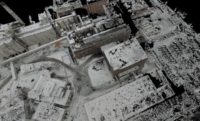Laser Scanning for Building Documentation: Illuminating, But Not Necessarily Enlightening
(Guest column for ENR)
As a surveyor working in the site/civil consulting world, I learned early on that the staying ahead of the technology curve can provide a clear market advantage, so I have been progressive in my adoption and use of new technologies as they come on the scene. From digital data collectors, robotic total stations, 3D CADD, GPS, to GIS, my 30-year professional career has been heavily impacted by the repeated adoption of new technologies.
So it’s no surprise that 3D Laser Scanning to develop building information modeling for existing conditions has made the list of current top, new technologies that are changing not only my surveying practice but the whole architectural and engineering world.
But I also have learned that there is one common requirement for the successful, broad implementation of any new technology—one which serves those who offer the technology commercially, as well as the end users— and that is the development of professional standards and best practices. Often early stage providers of new technologies overlook the need for this and the entire market suffers as a result.
The business of 3D laser scanning and BIM for existing conditions is adrift in a sea of uncertainty, where the deliverable of one honest service provider may be quite different from the deliverable of another—and neither serve the client’s needs because there are no standards and best practices to apply.
As the hardware and the means and methods for acquiring building documentation to create BIM for existing conditions have evolved, many stakeholders have entered the marketplace to provide existing-condition, building documentation services. Among them are architects, engineers, technicians, and land surveyors. But unlike the professions of land surveying or architecture, there are, as yet, no licensure or certification requirements in the U.S. for the performance building documentation services, and as a result, we now have a disorganized mix of providers offering it from various segments of the industry.
This begs the question of who is best qualified to perform a building survey? Architects and engineers are typically experts in buildings and building systems, yet they are not necessarily experts at measuring. Land surveyors are expert in measuring, but the understanding of buildings and building systems often falls outside their domain of expertise.
Consider these questions:
• How is a seeker of building documentation services to determine who is best qualified to perform such services?
• Where can service providers go to find information on best practices, standards and guidance on establishing, maintaining and growing a professional practice?
• And where does one go to tap into forums or networks of like-minded professionals for support and sharing of ideas and information?
To address these issues, in 2012 the U.S. Institute of Building Documentation (USIBD) was founded by a group of industry leaders with a desire to provide support and bring answers to these questions to this industry. Its mission is to further the excellence of building documentation by promoting, educating, guiding and supporting stakeholders with an interest in the built environment in a way that cultivates networking and information sharing. It is an organization solely dedicated to promoting and furthering the Building Documentation profession within the United States.
The USIBD’s mission is to promote and facilitate:
• Building Documentation as a distinct industry; establishing standards, guidelines and best practices to foster excellence in the productivity, quality and safety of the documentation process
• The codification of ethical practices to support and further the growing network of professionals dedicated to Building Documentation
• To encourage cooperation and the exchange of information among documentation professionals who are responding to growing interest in building documentation by owners/operators, service providers, government agencies, and the public
• To establish and promote a "Certified Building Documentation Professional" certification (CBDP)
• To serve as a core educational resource dedicated to the pioneering technology of the Building Documentation industry
• And to recognize individuals for outstanding dedication and service to the building documentation profession
In its effort to help bring the various stakeholder groups together the USIBD already is partnering with other leading industry organizations, such as the Associated General Contractor’s BIM Forum, the buildingSMARTalliance (bSa), the non-profit organization CyArk, which is dedicated to digitally preserving cultural heritage sites by collecting, archiving and providing of open access to recorded data created by laser scanning, digital modeling, and other state-of-the-art technologies, and The SPAR Point Group, a 3D imaging technologies conference organizer and information resource.
For more information on the USIBD please see the USIBD web site at www.usibd.org. This is an important period of new technology implementation for the construction industry and all stakeholders have a responsibility to help make sure we get it right.
Joseph E. Romano and John M. Russo are founding members of the USIBD. Romano is the principal of Langan Engineering and Environmental Services’ Surveying, Mapping and Scanning group and is based in New York City. (www.langan.com.) Russo is president and CEO of Architectural Resource Consultants, Irvine, Calif. (www.arc.corporate.com.)





